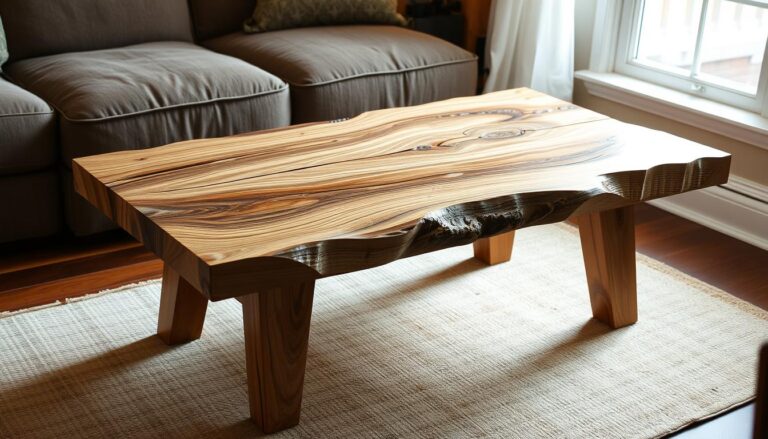Why Container Homes Are the Future of Affordable Living
Discover how container homes are revolutionizing affordable living with their sustainable design and eco-friendly advantages. Join the tiny home trend!
Imagine a world where owning a home is easy. A few years ago, I was stuck in a tough housing market. Then, I found container homes. They were like a hidden treasure, giving me a place to live and a chance to save money.
Container homes are becoming a sign of affordable living and green homes. What were once old metal boxes are now beautiful homes. They show us a new way to live.
Container homes are cheap, fast to build, and good for the planet. The advantages are many. Let's explore why they're key for living green and saving money.
Key Takeaways
- A basic container home can start as low as $10,000.
- These homes can be constructed in just a few months.
- Container homes repurpose materials, making them inherently eco-friendly.
- They can be tailored with energy-efficient systems like solar panels.
- Offer an affordable alternative in a challenging housing market.
Introduction to Container Homes
Ever wondered what a container home is? These homes use shipping containers to create affordable, efficient, and stylish living spaces. It's like turning an industrial item into a cozy home. Want to explore this fascinating world?
What is a Container Home?
A shipping container house is a house made from shipping containers. These strong, metal boxes are 8 feet wide and 8 feet 6 inches high. You can add windows, doors, and insulation to make it your own.
Historical Background
The idea of container homes started in the early 2000s. It was first for eco-friendly architects and DIY fans. But, the economic downturn and high housing costs made them popular. Now, states like Texas, California, and Oregon love them. Want to learn more? Check out how people are changing their homes.
Benefits of Container Homes
Container homes are becoming popular for good reasons. They are affordable and good for the planet. Let's look at why they're a great choice for your home.
Affordability
Container homes are very affordable. Traditional homes can cost a lot, but not these. You can get a strong, stylish home without spending too much.
For cost-effective housing, container homes are the best. They use old shipping containers, which saves money. This makes them perfect for saving money while having a unique home.
Sustainability
Container homes are also good for the Earth. They are a green choice compared to old building ways. Using old containers means less new stuff is needed and less waste.
Living in a container home means you care about the planet. They have special features to save energy, like well-insulated walls. You can also add solar panels and collect rainwater. This makes them a great eco-friendly dwelling.
Cost Efficiency in a Challenging Housing Market
The housing market is tough right now. Prices are high, and choices are few. But, container homes offer a new way to afford a home. They mix cost savings with cool design, all at a good price.
Container homes start at about $40,000. They are cheaper than traditional homes. Basic changes can cost under $50,000, saving you money.
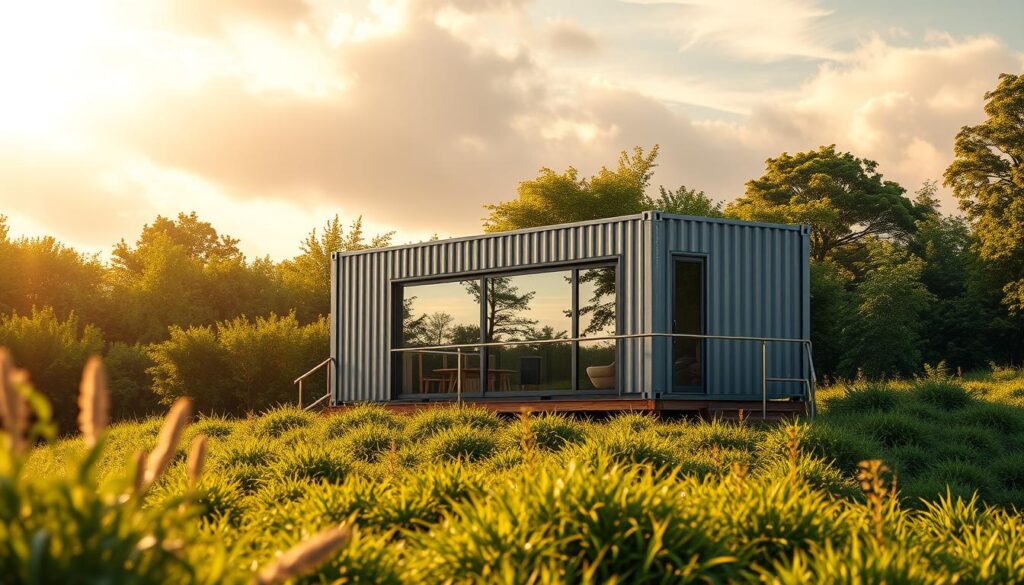
Container homes save money in the long run too. They need less upkeep, use less energy, and might cost less for insurance. Plus, they can be built fast, in weeks or months.
They also offer a smart way to make money. This is called concurrent project management. Want to learn more? Check out this cost comparison and see the savings for yourself.
In short, container homes are not just cheap. They are smart, modern, and good for the planet. So, why not look into them for your next home?
Sustainability and Environmental Impact
Container homes are leading the way in sustainable living. They show us how to live green in many ways.
Reuse of Shipping Containers
Container homes use old shipping containers. This is great for the planet. It saves trees and cuts down on waste.
Using local containers also lowers emissions. It's a win-win for our planet.
“The materials used in shipping containers are exceptionally durable, limiting the frequency of repairs and replacements, which leads to reduced waste generation.” – Alternative Living Spaces
Energy-Efficient Designs
Container homes save energy. They have special insulation and big windows. This helps them stay cool and warm.
They also use solar panels and wind turbines. These make them even greener. 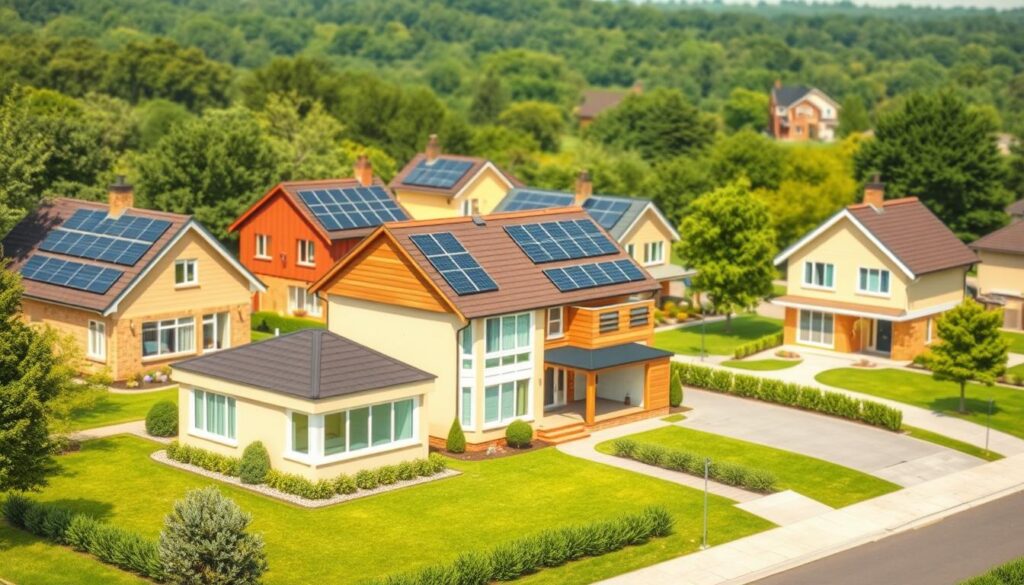
Learn more about the advantagesof container homes.
Use of Green Technologies
Container homes use the latest green tech. They have systems for collecting rainwater and composting toilets. This is just the start.
They also have solar panels and wind turbines. These make them very energy-efficient. They help lower carbon emissions too.
| Feature | Traditional Homes | Container Homes |
|---|---|---|
| Building Materials | Requires new, non-recycled materials | Made of up to 80% recycled materials |
| Energy Source | Mostly relies on non-renewables | Can fully operate on renewables |
| Construction Time | Several months to years | Few weeks to months |
| Environmental Impact | High carbon footprint | Low carbon footprint |
Switching to container homes is a big step towards sustainability. They show us how homes can be good for the planet. They're leading the way for the future of homes.
Versatility and Customization Options
Custom container homes are amazing because they can be made in so many ways. You can have a small cozy home or a big mansion. Architects and designers love working with these homes because they can do so much.
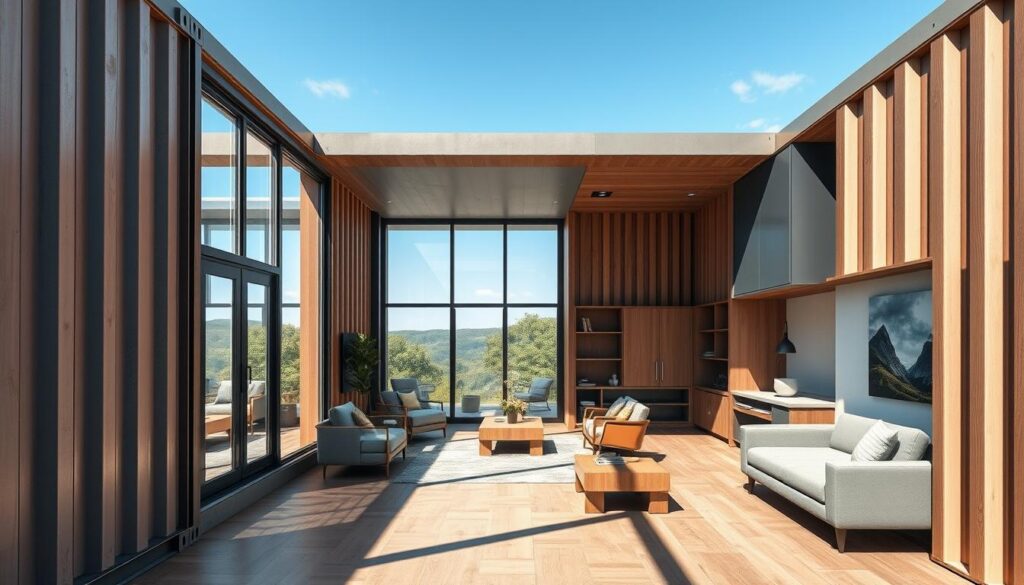
These homes can look any way you want. You can have a simple, open space or a home with many rooms. Custom container homes are like a blank piece of paper for your dreams.
You can pick how the outside looks too. You can choose from modern to wood. This makes sure your home is just right for you.
So, container homes are great for making a home that's both special and useful. They let you create a space that's truly yours.
Speed and Efficiency of Construction
Container homes are great for building fast. They are made in parts, so they go up quickly. This is much faster than building a regular house.
Quick Assembly Process
Container homes are easy to put together. They come to your site already built. Then, just a few tweaks and they're ready.
Imagine this: in just a few weeks, a metal box becomes a cozy home. It's pretty cool!
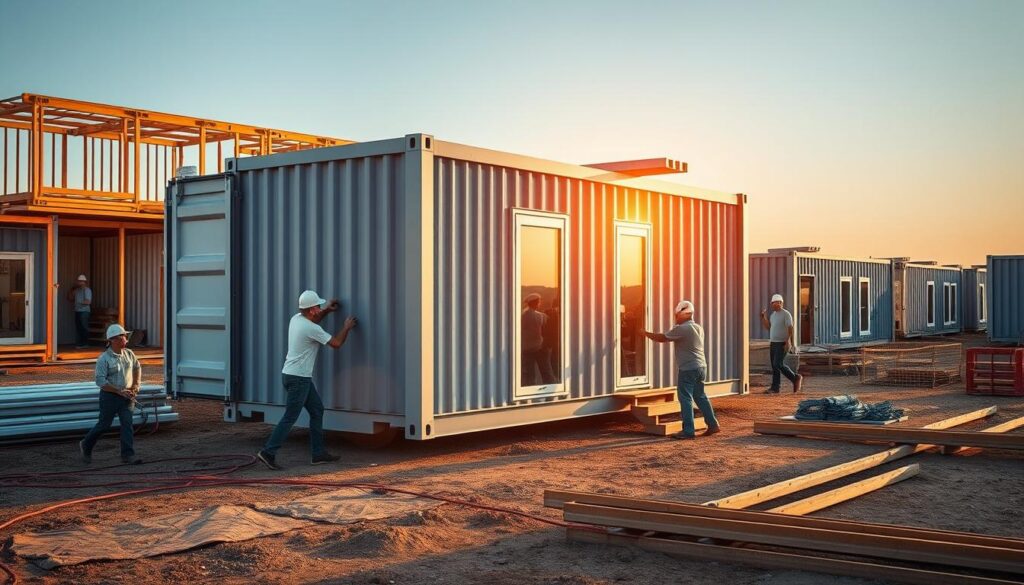
Reduction in Labor Costs
Container homes also save money on labor. They are built before they arrive, so less work is needed. This means workers spend less time on-site, saving money.
They also don't need special workers. This makes them even cheaper to build.
In short, container homes are quick and save money. They're perfect for today's fast-paced world!
Minimalist Living Trend
Our lives are getting busier. More people want a tiny home for simplicity and efficiency. This trend is about living better, not just smaller.
Minimalist design means only keeping what's important. It clears your mind and space. Imagine a tiny home where every inch is used well, making it cozy and useful.
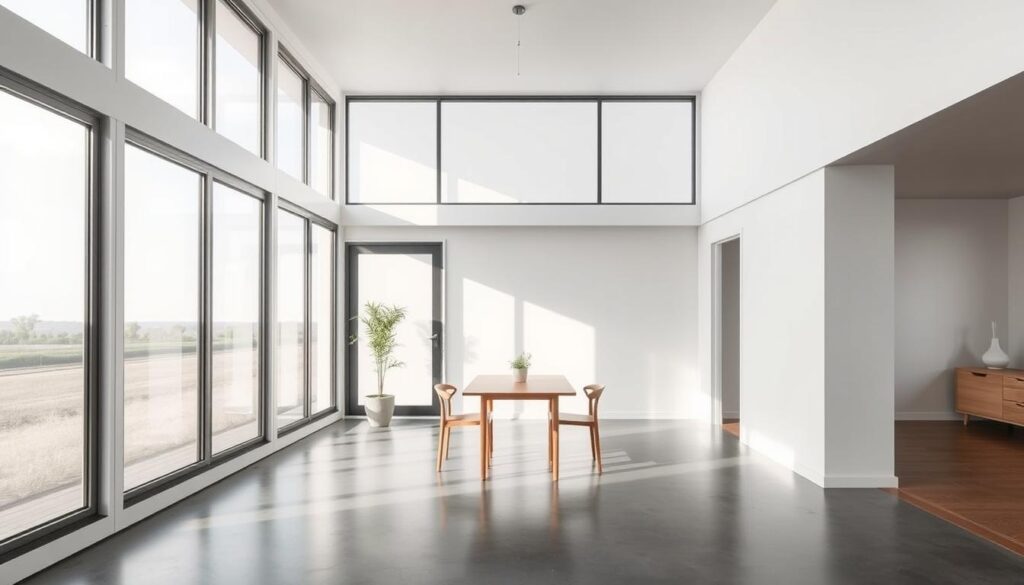
Compact living fits many lifestyles. It offers smart solutions for small spaces. You can have a place for work, storage, or living all in one.
Here are some key features and their benefits:
| Feature | Benefits |
|---|---|
| Multi-functional Furniture | Maximizes space efficiency; enhances room versatility |
| Smart Storage Solutions | Reduces clutter; improves organization |
| Energy-efficient Appliances | Lower utility bills; eco-friendly |
| Natural Light Integration | Brightens space; reduces need for artificial light |
Choosing a tiny home is more than small living. It's about living simply and happily. Being mindful of our space helps us find joy and live better.
Case Studies of Container Home Projects
Looking at real-life examples of container homes shows us a lot. We see how they help with urban housing, rural needs, and building communities. Let's check out some successful projects that show how versatile container homes are.
Urban Solutions
In cities like Los Angeles and New York, space is tight. But, people need homes. Container homes are a smart solution. They are stylish, affordable, and good for the planet.
Rural Applications
In the countryside, container homes are a smart choice. They are strong and can stand up to weather. In Texas, they've built homes that are off the grid and self-sufficient. These homes meet the special needs of rural life.
Community Housing Projects
Container homes are great for living together. The Container Park in Las Vegas is a perfect example. It turns old containers into a lively area with shops, food, and homes. This shows how container homes can bring people together and help the local economy.
Economic Advantages of Container Homes
Container homes are a smart choice for saving money. They are cheaper than regular houses. Plus, they can be a good investment.
Cost Comparison with Traditional Homes
Let's see how container homes compare to regular houses. Here's a simple comparison:
| Aspect | Container Home | Traditional Home |
|---|---|---|
| Construction Cost per sq.ft | $150 | $250 |
| Construction Time | 3-5 months | 7-12 months |
| Maintenance Cost | Low | High |
Long-term Financial Benefits
Container homes are great for saving money in the long run:
- Lower utility bills: They use less energy, saving you money.
- Durability: They last longer, needing fewer repairs.
- Investment opportunities: They're becoming more popular, making them a good investment.
Container Homes: A Solution for Homelessness
Homelessness has jumped by 12% in 2023. Communities are looking for good solutions. Container homes are a promising answer. They are affordable, green, and can be set up fast.
Successful Implementations
In Atlanta, Georgia, “The Melody” is a big success. It has 40 container homes for people without homes. Denver, Colorado, has also done well, moving over 1,500 people into new homes.
In Evansville, Indiana, two new homes were built in September 2024. They show how well container homes can work for affordable housing.
Impact on Communities
These projects do more than just give people a place to stay. Newark, New Jersey's “Hope Village” II has WiFi, bathrooms, and kitchens. This helps people feel like they belong.
Want to know more about these amazing stories? Check out the Tradecorp USA blog for more info.
Changing The Way We Think
Container homes are changing the way we think about living spaces. They are affordable and good for the planet. This makes them a great choice for many people.
These homes use old materials and save energy. They are quick to build, which is perfect for today's housing needs. This makes them a smart option for many.
Container homes can be used in many ways. They work well in cities and in the countryside. You can make them fit your needs perfectly.
They are good for communities too. They help people find homes and bring people together. This makes them a positive force in society.
Container homes are more than a trend. They are a step towards living better and saving our planet. They offer a way to live that is both green and affordable.
If you're ready to start, the Build A Container Home guide is a great resource—it shows you how to design and construct your own sustainable space step by step.


